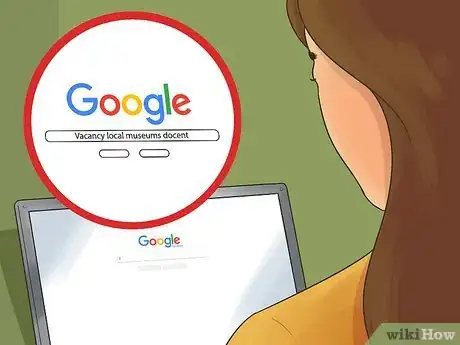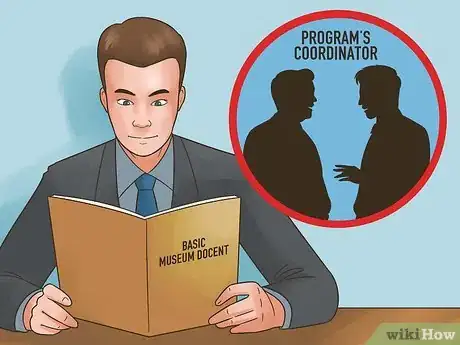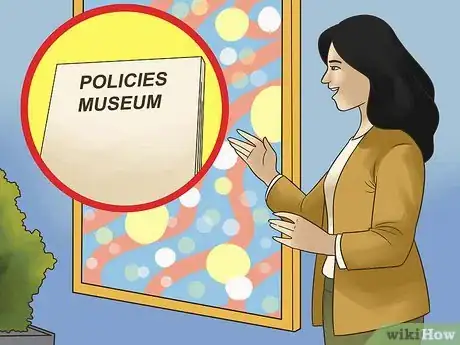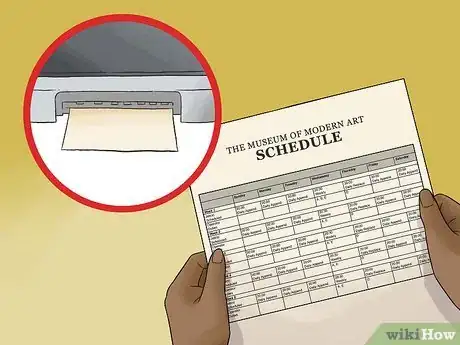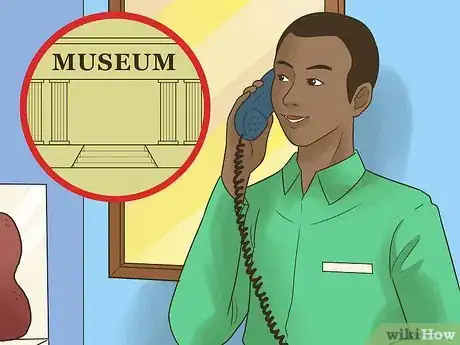This article was co-authored by wikiHow Staff. Our trained team of editors and researchers validate articles for accuracy and comprehensiveness. wikiHow's Content Management Team carefully monitors the work from our editorial staff to ensure that each article is backed by trusted research and meets our high quality standards.
There are 16 references cited in this article, which can be found at the bottom of the page.
wikiHow marks an article as reader-approved once it receives enough positive feedback. In this case, 96% of readers who voted found the article helpful, earning it our reader-approved status.
This article has been viewed 56,315 times.
Learn more...
A docent is a guide or lecturer at a museum, art gallery or zoo. Docents at a museum lead tours for children and adults. No background is needed but an enthusiasm for the museum’s subject matter and a willingness to educate others is advised. Docent work is typically done on a voluntary basis, but this experience in study and public speaking serves as an excellent resumé or curriculum vitae builder for paid museum jobs in the future.[1]
Steps
Researching the Work
-
1Identify the type of museum where you would like to lead tours. Is it an art museum, a science museum or a natural history museum? Take a moment to reflect, as choosing the right location will enable you to enjoy yourself more and perform better as a docent.
- Consider your interests. Did you grow up playing with dinosaurs? Choosing a natural history museum with dinosaur bones will allow you to reconnect with your passion and share your enthusiasm with guests.[2]
- Consider your studies, too. This can be helpful in learning more about your selected field - or you can choose to explore an entirely new interest. It is volunteer work, so it is an opportunity beyond the confines of school and work.
- Ask yourself why you want to be a docent in the first place. If it’s to practice speaking or volunteering, it may not matter so much what you choose. Research local museums and you may find an opportunity with people or in a place that you love, no matter how big or small.[3]
-
2Check listings in your local area for museums in your discipline of choice. Every museum has different requirements for its program. Take note of when training classes are offered and if they have any vacancies.
- You likely associate museums with large cities, but so does everyone else. To get started, you may wish to search locally.
- Information on docent programs can often be found online, but you can also visit in person or call to signal your interest to the coordinator.[4]
Advertisement -
3Request information about the museum’s docent program. Once you’ve read the basics, call the program’s coordinator. Not only will this serve as a personal and memorable introduction, but this person can provide more details and guidance.
- Despite this being volunteer work, many museums have sizeable requests, including commitment periods of a year or more. Make sure you understand what you’re getting into before you begin.[5]
-
4Research the topics of permanent exhibits. Even though this is volunteer work, the museum stakes its reputation on docents who interact with the public. Knowledge will help you impress an interviewer.
- For art, for instance, knowing about the piece's medium, era, influences, and effects prompt more of a discussion with patrons than merely listing off the artist and the subject.[6]
- To find details of the subject matter, do some online reading or spend time at the museum. Take tours, read plaques, and listen to the docents.
- Ask questions about the museum’s history, too. What is its mission? Staff can help you with this, but you’ll likely find it on the museum’s website.
- If this is an area of particular interest, you can even consider classes at a local college. Check for guest lecturers, displays, discussion groups, or anything that will allow you to discuss your interest.
-
5Interview with the museum of your choice. Museums at a minimum require docents to lead tours, while some may wish you to prepare exhibits, facilitate activities, or even represent them in the outside world. If an interview is necessary, have your speaking skills sharp.[7]
- The interviewee will be interested in your ability to speak to large groups. Remember that you’ll have to speak in a way that everyone can hear, often while moving through an open area.
- Come to the interview with questions. This often leaves a good impression because it displays your interest while simultaneously allowing you to fill in the gaps in your knowledge.
- Display appropriate body language. Sit or stand tall, make eye contact, and smile. Again, you are representing the museum and no guest or interviewer will appreciate someone who appears slouched and unfriendly.
Training to Become a Docent
-
1Take a tour with a museum docent. This will give you a chance to not only witness first-hand the tasks you’ll have to perform, but pick up useful tips and museum information from an experienced docent.
- Tune your ears to the most essential exhibits. Others may come and go by the time you begin, but the ones the museum keeps have meaning to that location and often unique stories.
- Note the way the docents hold themselves. Can you hear them from the back? Are they friendly and informative? You’ll find clues that you can use to refine your own behavior.
- A docent has to compact much information into a simple answer while still encouraging questioning. Don’t be afraid to ask whatever you would like to know about the museum or the work, but still observe the tricks they use to speak effectively.[8]
- If possible, lead a trial tour with an experienced docent. They can offer you constructive criticism as well as note-taking strategies to refine your speeches to the most essential information.
-
2Begin functional training. It isn’t enough to know the subject material; a docent must also know about the museum, its policies, and how to interact with guests and staff. This portion of the training may be as trying as the actual education.
- Training begins with insight to the museum and its mission. This, along with gallery sessions, will familiarize you with the museum and allow you to answer questions that go beyond the exhibits.
- Lessons on touring techniques will be offered, and oral presentations may be mandatory. Use these to familiarize yourself with the verbalization you’ll need to succeed.
- Some programs include study groups and docent trips to other museums. Interacting with guests is important, but you must also know how to talk to your fellow docents.[9]
- Understand the museum's policies as well. Many museums do not allow food, beverages, or photography. If a display is cordoned off and touching not permitted, you will be responsible for enforcing this.
-
3Begin educational training. All museums have different programs, many quite extensive. They exist to ensure you are well-prepared and by the end, your diligence and attentiveness will have an effect on your capability to educate.
- The Arizona-Sonoma Desert Museum, for instance, requires a minimum two-year commitment, 144 hours a year, classes, training, and workshops. Even if you have no experience, you’ll get a chance to learn from the museum staff.[10]
- Some programs also require seminars, written, and oral tests. It’s a significant time investment, but this school-like atmosphere is designed to ensure you understand the subject material of the museum.[11]
-
4Practice your material. Recite it in a mirror, around exhibits, and with friends asking questions. Public speaking can be difficult, but practice and familiarity can help you grow comfortable.[12]
Beginning as a Docent
-
1Conduct your first tour. It can be intimidating to be responsible for a group of visitors in a large space. Remember your preparation; figure out ways to stay calm. This is a learning experience for you too, so don’t sweat the mistakes.[13]
- Engage your group in conversation to get comfortable. Make eye contact. Do not speak too quickly and pause between sentences.
- Remember that you represent the museum, even as a volunteer, so treat every guest with patience and respect.[14]
- Move at a reasonable pace, stopping to ensure everyone is with you before continuing onto the next topic. Never speak as you lead the group; it is difficult for people behind you to hear.
- Consider the tour to be a conversation, and that silence is necessary from time to time for you to collect your thoughts and others to digest your knowledge. [15]
- Ask your group if they have any questions at the end of the tour.
-
2Schedule with the museum. Different museums have different requirements, but many ask for certain shift lengths and hours over a commitment period. Keep aware of the museum's tour schedule.
- The Museum of Modern Art in New York City, for instance, asks for three hour shifts once per week or twice per month on weekend.[16]
- Museums require long-term commitments, which you’d have come across in research and training. Remember to keep up with it!
-
3Study for new exhibits as needed. Art galleries, for instance, may change their exhibits every two to three months, so you’ll have to repeat previous steps to make sure you have appropriate information to give!
- Some museums also include regular training sessions, which will keep you informed of any changes and teach you more of what you need to be able to provide guests.
-
4Perform other requirements. While the main task of a docent is to lead tours, many museums will provide other opportunities. This can be anything from preparing exhibits to visiting classrooms.
- You may have to research on the job. An art museum gaining a new piece will have you find out the background material and prepare it for public consumption.
- As a representative of the museum, you may be asked to visit the community. Your work is to educate the public and interest them in what the museum offers, so this can include presenting at a community center or school.
- Whether it be informative play for children or adult education, those activities you see at the museum don’t run themselves. You’ll be asked to oversee some of them.
- Docents may also be asked to perform greetings, answer phones, or other clerical tasks. This is why a wide base of knowledge and social skills are valuable. You'll be expected to balance working with guests and working with information.
Community Q&A
-
QuestionWhat is the origin of the word docent?
 DonaganTop Answerer"Docent" derives from the Latin word meaning "to teach."
DonaganTop Answerer"Docent" derives from the Latin word meaning "to teach."
References
- ↑ http://www.daytonartinstitute.org/about-dai/volunteer/become-docent
- ↑ https://www.themuse.com/advice/do-what-you-love-how-to-identify-pursue-your-passions
- ↑ https://www.mindtools.com/pages/article/career-opportunities.htm
- ↑ http://rubinmuseum.org/page/volunteer-docent-program
- ↑ http://rubinmuseum.org/page/volunteer-docent-program
- ↑ http://www.heckscher.org/downloads/ED12_BecomeaDocent_Handbook.pdf
- ↑ http://terc.ucdavis.edu/ed-outreach/documents/docent-training/1docent-program-info.pdf
- ↑ http://www.museum-ed.org/helping-visitors-ask-better-questions/
- ↑ http://artmuseum.princeton.edu/learn/participate/museum-docents
- ↑ https://www.desertmuseum.org/center/edu/docents.php
- ↑ https://deyoung.famsf.org/education/fine-arts-museums-docent-programs
- ↑ https://www.toastmasters.org/Resources/Public-Speaking-Tips/Preparing-a-Speech
- ↑ http://www.quickanddirtytips.com/business-career/public-speaking/6-tips-to-calm-your-nerves-before-speaking
- ↑ https://nonprofitquarterly.org/2015/07/21/boomers-gone-wild-as-museum-docents-nightmare-or-real-life/
- ↑ http://tallblog.conted.ox.ac.uk/index.php/2012/10/03/leading-a-walking-tour-a-step-by-step-guide/
- ↑ https://www.moma.org/about/volunteering
- ↑ http://mocanomi.org/wp-content/uploads/2011/11/Museum-of-Contemporary-Art-Docent-Program.pdf

